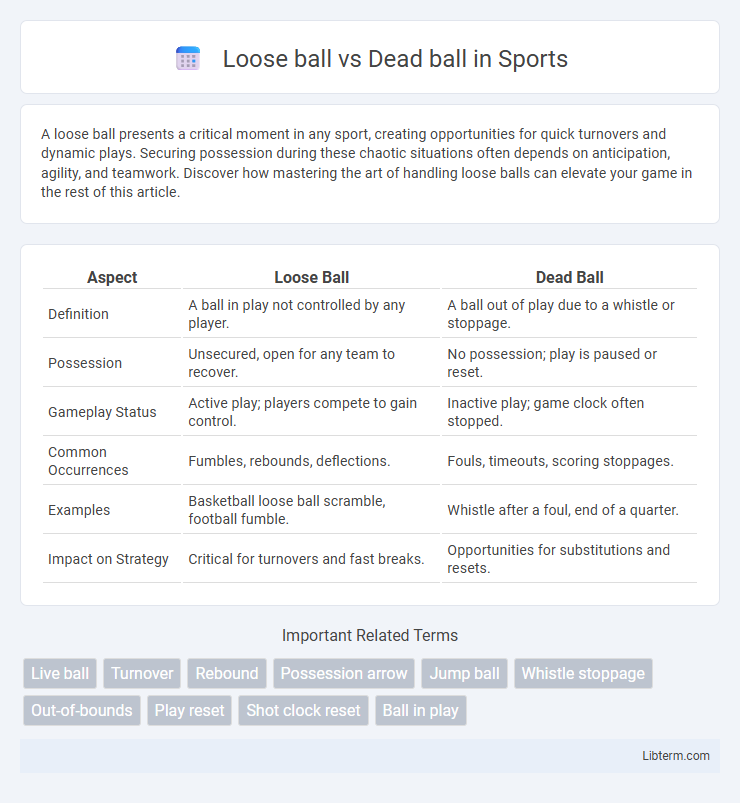A loose ball presents a critical moment in any sport, creating opportunities for quick turnovers and dynamic plays. Securing possession during these chaotic situations often depends on anticipation, agility, and teamwork. Discover how mastering the art of handling loose balls can elevate your game in the rest of this article.
Table of Comparison
| Aspect | Loose Ball | Dead Ball |
|---|---|---|
| Definition | A ball in play not controlled by any player. | A ball out of play due to a whistle or stoppage. |
| Possession | Unsecured, open for any team to recover. | No possession; play is paused or reset. |
| Gameplay Status | Active play; players compete to gain control. | Inactive play; game clock often stopped. |
| Common Occurrences | Fumbles, rebounds, deflections. | Fouls, timeouts, scoring stoppages. |
| Examples | Basketball loose ball scramble, football fumble. | Whistle after a foul, end of a quarter. |
| Impact on Strategy | Critical for turnovers and fast breaks. | Opportunities for substitutions and resets. |
Understanding Loose Ball and Dead Ball: Key Differences
Loose ball refers to a situation in sports where the ball is in play but not controlled by any player, often leading to a scramble to regain possession. Dead ball occurs when play is stopped, usually after a foul, out-of-bounds, or scoring, and no actions involving the ball can affect the game until play resumes. Understanding the key differences between loose ball and dead ball is essential for players and referees to manage game flow and enforce rules accurately.
Defining Loose Ball in Sports Contexts
A loose ball in sports refers to a ball that is free and not controlled by any player, often occurring after a fumble, deflection, or rebound. This situation requires players to quickly gain possession, creating dynamic and unpredictable moments in games like basketball, football, and soccer. Strategies for recovering loose balls heavily influence team performance and often shift momentum during competitions.
What Constitutes a Dead Ball?
A dead ball occurs when play is temporarily stopped according to specific rules, such as when the ball goes out of bounds, a foul is called, or a timeout is requested. The ball must be completely at rest or out of play to be considered dead, preventing players from gaining an advantage during the stoppage. Unlike a loose ball, which remains live and contestable, a dead ball halts all action and resets the game for the next play.
Loose Ball Rules Across Major Sports
Loose ball situations occur when the ball is free on the playing surface without clear possession, triggering specific rules to determine player access and game continuation. In basketball, a loose ball results in a scramble where players can jump ball if possession is unclear, while in football, the ball is live for recovery during fumbles and kickoffs. Baseball treats a loose ball as a live ball unless it becomes a dead ball due to timeouts or rule infractions, highlighting variations in how sports manage ball control and maintain game flow.
Dead Ball Situations: Common Scenarios
Dead ball situations commonly occur during timeouts, fouls, and when a player steps out of bounds, halting play and allowing for player substitutions or strategic adjustments. Another frequent dead ball scenario happens after made baskets, where the ball is inbounded from the baseline, resetting possession and initiating the next offensive play. Understanding these situations is essential for coaches and players to manage game flow and implement effective tactics during stoppages.
Impact of Loose Ball on Game Flow
Loose balls create dynamic shifts in game flow by increasing player engagement and scoring opportunities, often leading to fast breaks and momentum swings. The heightened intensity during loose ball situations demands quick decision-making and can disrupt the opposing team's defensive organization. This unpredictability intensifies competition, significantly influencing the pace and outcome of the game.
When Does a Ball Become Dead?
A ball becomes dead in basketball when play is stopped due to fouls, violations, or when the ball goes out of bounds, preventing further active play. A loose ball occurs when the ball is not in possession of either team during active play, often leading to a scramble for control. Understanding the distinction is crucial for officiating and game flow management, as a dead ball halts gameplay while a loose ball keeps the action live and contested.
Player Actions During Loose Ball and Dead Ball
During a loose ball, players aggressively chase possession, utilizing quick footwork, anticipation, and physical contact to gain control, often resulting in scrambles and hustle plays. In contrast, during a dead ball, players typically pause, reposition, and communicate strategically, preparing for set plays or rest while avoiding physical contests. Understanding these distinct behaviors enhances game flow analysis and player decision-making during basketball or football matches.
Referee Decisions: Loose Ball vs Dead Ball
Referee decisions on loose balls involve active play situations where the ball is free and contested by players, requiring officials to monitor possession, fouls, and out-of-bounds rulings in real-time. Dead ball decisions occur when play is halted due to fouls, violations, timeouts, or scores, prompting referees to reset positions, administer penalties, or manage substitutions. Accurate differentiation between loose ball and dead ball scenarios ensures proper enforcement of game rules and maintains the flow and fairness of the match.
Strategic Implications: Loose Ball vs Dead Ball
Loose ball situations in sports like basketball and football create dynamic opportunities for turnovers, requiring players to exhibit heightened agility and quick decision-making to regain possession. Dead balls offer strategic pauses where teams can reorganize formations, plan set plays, or substitute players, maximizing control over the game's pace. Understanding the contrast in these states is crucial for coaches to design effective strategies that exploit loose ball chaos or dead ball structure to gain competitive advantage.
Loose ball Infographic

 libterm.com
libterm.com